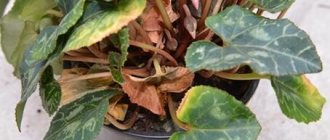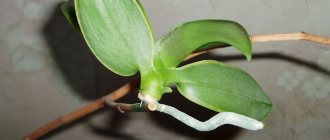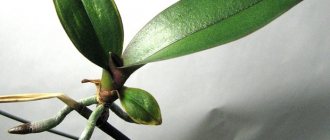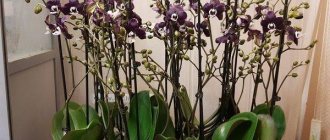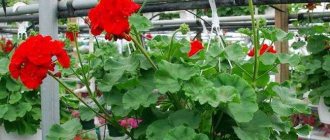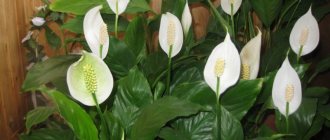Delicate, like the wings of a butterfly, Cyclamen in bloom is incredibly beautiful. There are simply not enough words to describe its delicate inflorescences, which look like a cluster of butterflies in fragrant greenery. You need to see this with your own eyes. The cyclamen flower requires special care at home. Cyclamen at home blooms as brightly and violently as in the wild. Naturally, the conditions should be as close to natural as possible. The natural habitat of cyclamen is the Mediterranean coast. These plants love bright sun, warmth, and humid air.
How to determine that a flower needs replanting?
You can determine that a flower needs replanting based on the following signs:
- the roots begin to crawl out of the drainage hole;
- flowering becomes less active.
These flowers are sold to stores in small pots, and the soil in which they are planted is most often ordinary high-moor peat.
Sellers usually feed the plants with fertilizers so that they actively bloom, but the peat is quickly depleted, so experts recommend replanting the cyclamen after purchase into another pot filled with a nutrient substrate.
If the roots begin to emerge from the drainage hole, this indicates that the pot has become too small for the plant. In this case, transplantation into a larger container is required.
Possible problems
If the leaves of young cyclamen begin to turn yellow, the cause may be both high temperature in the apartment and dry air. Often the reasons are combined. To prevent this situation, containers with plantings should be placed on window sills, under which there are no batteries, and regular spraying should be carried out. Alternatively, the pots can be placed on a tray filled with constantly moistened pebbles. To quickly correct the situation, cyclamen will have to be immediately removed from the battery, moved to a room where the temperature does not exceed +18 degrees, and spraying should also begin.
When the flowers are healthy, but the leaves still turn yellow, the problem may be excessively high temperatures. By returning the readings to +18 degrees, it will be possible to eliminate the problem. Sometimes leaf blades turn yellow due to the fact that the substrate is not sufficiently moistened. It is clear that in this case it is enough to simply increase watering frequency. Finally, the leaves may turn yellow and fall off after the cyclamen blooms, which is an absolutely natural phenomenon. This phenomenon suggests that the plant is simply adjusting to a state of rest. If the leaf shedding is too intense, it is better to move the plantings to other rooms.
When the root system begins to rot, the problem may lie not only in excess liquid, but also in the fact that it pours directly onto the top of the tuber - its rosette. Otherwise, the core of the flower not only rots, but also becomes moldy. If cyclamen leaves begin to deform, this may indicate pest attack. The miniature cyclamen mite cannot be seen on the surface of the leaf blade, but its impact leads to curling of the leaf edges and cessation of their development. In such a situation, the damaged parts of the plant should be immediately eliminated, and then all plantings should be treated with insecticides.
Gray mold occurs when the plant is kept in high humidity and the temperature remains too cold. As preventive measures, experts advise regularly ventilating the room and keeping the temperature at +18 degrees.
You will learn more about propagating cyclamen at home in the following video.
Is it possible to replant a flowering plant?
Experienced flower growers and specialists warn: flowering indoor plants should not be replanted. During the flowering period, plants spend a lot of energy and nutrients on the formation of buds and flowering, so after transplantation at this time the cyclamen will shed its petals, will take a long time to acclimatize in the new pot and most likely will not bloom this season.
Note! But still, sometimes cyclamen has to be replanted during flowering in exceptional cases. One of these exceptional cases is the forced pre-sale forcing of plants. As a result, cyclamen blooms ahead of schedule, and after flowering almost always dies.
Only an emergency transplant can save this flowering plant. All the buds of the cyclamen are cut off and a pot is prepared for replanting. It is filled with soil that contains little fertilizer and no growth stimulants. And before the next period of natural flowering, the transplanted plant needs to create all the conditions so that it “falls” into a state of dormancy. In this case, the next flowering of cyclamen will take place within the time frame prescribed by nature.
Plant care rules
In order for the plant to delight with a cap of bright flowers, it is necessary to provide it with comfortable conditions. How to care for cyclamen at home? Beginners in keeping this plant should pay attention to several main points:
- priming;
- room temperature;
- watering;
- lighting;
- feeding
Secrets of watering
One of the first questions when purchasing a plant is how to properly water cyclamen. Improper agricultural practices are a common cause of plant death. It is recommended to water cyclamen through a tray. This method allows you to avoid moisture getting on the tuber and growing point. But it is worth considering the hardness of the water. A large amount of salts negatively affects the root system. Hard water must be left to stand for several days or filtered. When watering through a tray, the water is left to soak into the ground for an hour. Then the remaining liquid is drained. It is better to carry out the procedure in the morning; during the day the soil dries out slightly.
Advice. A solution of succinic acid (1 tablet per 1 liter of water) helps to dissolve and wash away excess salts from the soil. Use once a month. Instead of succinic acid, you can take aspirin.
It is permissible to water the plants from above; the moisture flows carefully along the edge of the pot. Cyclamen loves cool weather, so some gardeners replace watering with ice cubes or snow. This procedure is desirable in the summer heat. The recommended water temperature for irrigation is 2-3° lower than the room temperature.
Choosing a pot and soil
The substrate for planting the plant can be purchased at the store. Suitable universal soil for flowers, soil for violets or geraniums. Adding sand and perlite will help make it looser and more moisture-absorbing. The soil for cyclamen should be slightly acidic or neutral. You can cook it yourself. Required:
- leaf soil - 3 parts;
- humus – 1 part;
- peat – 1 part;
- sand - 1 part.
The soil taken for the mixture on the street must be disinfected - heated in the microwave or spilled with a solution of potassium permanganate. There must be drainage at the bottom of the pot. Expanded clay, small pebbles, and gravel are used as materials. And foam balls, which are recommended for other indoor plants, are not suitable in this case.
For cyclamen, plastic and ceramic pots with drainage holes are used. It is better to choose a design designed for bottom watering. You should not look for a large container; for adult plants the optimal diameter is 14-15 cm, and for young plants it should be smaller. You should choose a pot for cyclamen according to the dimensions of its tuber. There should be 2-3 cm from the edge of the bulb to the edge of the pot. In this case, the indoor flower develops correctly and blooms on time. A large container provokes increased humidity and root rotting.
Conditions of detention
All types of cyclamens love coolness, a comfortable temperature in summer is 18-22°, and in winter – 12-14°. Increased temperatures should be avoided, especially for purchased plants. Otherwise, they may go into a dormant state. Flowers need diffused light; direct rays are destructive. The room must be ventilated frequently, but cyclamens should not be exposed to drafts.
West and east sides are recommended for placing flowers. They love humidity; if the air is too dry, the leaves are carefully sprayed. But with the appearance of buds, they switch to another way to increase humidity. The pot is placed in a tray with wet moss or expanded clay. For feeding, liquid complex fertilizers are recommended, which are applied along with watering. The plant needs additional nutrition during the period of active growing season and bud formation.
Attention. For cyclamens, use half the dosage recommended by fertilizer manufacturers.
The frequency of fertilizing is once every two to four weeks. When choosing a drug, you should pay attention to the nitrogen content. Bulbous plants are contraindicated in excess amounts of this element. The cyclamen flower does not need special care after flowering. It is enough to remove dried flower stalks and leaves, and place the tuber in a dark place. Watering is very rare, fertilizing is excluded.
Determining the type of cyclamen
At home, gardeners grow the following varieties of cyclamen:
- Persian - this species has leaf blades that are quite large, uniformly dark emerald in color on both sides. The color palette of blooming flowers is wide. The first buds appear in the first ten days of November, flowering continues until spring. Then, for all varieties of Persian cyclamen, a period of dormancy begins. When planting, tubers of this variety are buried in the ground 2/3 of the length of the bulb;
- European - significantly different in appearance from Persian cyclamen. On the underside, the small leaves of this cyclamen are dark red. The flowers are smaller than those of the Persian, the color of the petals is soft pink. The blooming buds exude a pleasant, delicate aroma. The first buds on European cyclamen may appear in the first ten days of March, and the last flowers fall in the fall. The leaves of this plant do not turn yellow or fall off even during the dormant period, so this cyclamen does not lose its decorative value throughout the year. When planting, the tubers of this green “pet” are completely covered with a layer of soil;
- purple is an evergreen (sometimes deciduous) tuberous perennial plant, reaching a height of 9.5 cm, a rosette diameter of about 9 cm. The foliage is round or heart-shaped, dark emerald in color on the upper side of the leaf blades, the color of the leaves below can be red with a purple tint. The blooming buds have a pleasant smell, the color of the petals ranges from light carmine to rich red. The first flowers appear in the second ten days of July, and the last ones fall in the last ten days of August - the first ten days of September.
Any of these types of cyclamens will be a beautiful addition to the room interior, and the choice of a specific variety is up to the gardener himself.
Reproduction
To propagate cyclamen, seeds or the method of dividing the tuber are used. Each method has its pros and cons.
Propagation by seeds
Growing cyclamen from seeds is a long and labor-intensive process. Seeds can be purchased at a flower shop or obtained independently. To obtain seeds from home cyclamen, it is necessary to carry out artificial pollination. To do this, pollen is transferred from one flower to the pistil of another using a soft brush. If there are several alpine violets in the house, then cross-pollination is carried out - pollen is transferred from one flower to another.
The ovary is better formed if pollination is carried out on a sunny morning. In this case, pollen transfer is carried out several times, which increases the likelihood of ovary formation. Before pollination, it is recommended to feed the flowers with the following composition: dissolve 1 gram of superphosphate and 0.5 grams of potassium sulfide in one liter of water.
Seeds are sown in August, before the beginning of the growing season. The seeds are first filled with a five percent sugar solution. The floating seeds are discarded. Then soak the remaining seeds in a zirconium solution for a day to improve germination.
An earthen mixture consisting of equal parts of peat and leaf soil, or a mixture of peat and vermiculite, is poured into the planting container. The soil is moistened and the seeds are sown on the surface, sprinkled with a thin layer of soil. The container is covered with film and placed in a shaded place with a temperature of 18 to 20 degrees. Periodically moisten the soil with a spray bottle and ventilate. Shoots appear in a month and a half.
After the leaves appear, the film is removed and the seedlings are moved to a lighted place without exposure to sunlight. In this case, the temperature should be lower - 15-17 degrees. In December, the seedlings develop two or three leaves and form a small nodule. They can be replanted with a pick into a new mixture, which is made up of two parts of leaf soil, one part of peat and sand in half the dose. When transplanting, the tubers are sprinkled with soil. Picked seedlings are fertilized with complex fertilizers in half the dose a week after transplantation. Before the onset of the dormant period (second half of spring), the seedlings are transplanted into separate pots, leaving a third of the tubers protruding from the ground.
It takes 13-15 months from sowing to flowering. Plants grown from their own seeds acclimatize better than seedlings from purchased seeds.
This may be interesting: Caring for popular varieties of Episcia
Propagation by tubers
Most gardeners propagate cyclamen at home by dividing the tubers. During the dormant period, the tuber is removed from the pot and divided into several parts. There will be as many parts as there are growth points on the mother tuber. The sections are slightly dried and sprinkled with activated carbon powder or Kornevin. Then the parts are planted in separate containers in the usual mixture for cyclamen. Its composition was given above.
Despite the apparent simplicity of this method of propagation, the death of both the new plant and the mother tuber is often observed. Cut tubers are susceptible to rot.
When to replant?
All types of these indoor “pets” need to be replanted only after flowering has ended, when they enter the dormant stage. Different types of cyclamens are transplanted in different ways.
The Persian variety requires replanting twice a year. In the last ten days of May or the first ten days of June it is planted so that the tuber is only slightly covered with a layer of soil. When the leaf rosette grows, the plant is replanted again, with 1/3 of the tuber above the soil surface.
The purple variety should be replanted once every 3-4 seasons in the spring, before active growth of green mass begins.
The European type of this flowering plant is replanted after flowering ends - in the last ten days of September.
Step-by-step instructions for replanting cyclamen
Replanting these home flowers is not difficult, but you need to follow a number of rules:
- The first layer laid out on the bottom of the container is drainage. You can use medium expanded clay, medium-sized pebbles or crushed pieces of bricks;
- then the pot is filled with the prepared nutrient soil mixture, not reaching its edges by 2-2.5 cm;
- the plant is removed from the pot along with the earthen lump, the soil is carefully shaken off the roots;
- The root system is carefully inspected before planting in a new location. If there are dried, damaged or broken roots, they need to be cut with a sharp knife, and the cut areas should be treated with wood dust;
- The tuber is placed in the center of the pot, spreading the roots to the sides. The top is covered with the remaining nutrient substrate. The top of the root head must be left open.
We must remember! The transplant is carried out carefully, trying not to damage the roots. Otherwise, the plant will be sick for a long time. If the roots are severely damaged, it may simply die after transplantation.
It is important to properly water the flower after replanting. Water is poured into the pot in portions, waiting until the previous moisture is completely absorbed into the ground.
What to do with cyclamen after purchase
So, as soon as a mysterious butterfly flower appears in the house, it needs to be given time to adapt. Flower shops have completely different conditions. It is always light and humid there, and besides, all specimens grow in a transport substrate. During the first 2 weeks, the plant will get used to and adapt to its new place of residence. Then it should be transplanted into nutritious soil.
The tuber must be checked for diseases (rot).
To do this, it must be completely cleared of the substrate and rinsed well. It is advisable to soak even completely healthy cyclamen for disinfection in a weak solution of potassium permanganate. And biostimulants, for example, Epin, will help strengthen the immune system.
The soil for cyclamen needs to be nutritious, but at the same time light, so that the water does not stagnate. If the soil is too dense, it will take longer to dry out. In constantly wet soil, the tuber may rot. Ideally, you can purchase a special substrate for cyclamen for planting. There is no need to add anything to it, the maximum is to lay a drainage layer of expanded clay on the bottom of the pot.
You can make a loose fertile mixture yourself by mixing:
- 5 parts leaf soil;
- 2 parts humus;
- 1 part each of river sand and peat chips.
It’s also a good idea to add some wood ash to your homemade substrate. It will prevent alkalization of the soil, which is very harmful to cyclamen.
Also, such a soil mixture is subject to mandatory sterilization. This can be done by calcining the soil in the oven, exposing it to frost, pouring boiling water or a solution of potassium permanganate.
How to plant cyclamen
This flowering plant is planted in the following ways: dividing tubers or rosettes.
Tuber separation:
- the bulbs are removed from the pots and dried thoroughly;
- then divide them into parts, each of which should have a bud and a couple of roots;
- place the cuttings in a shaded place to dry the sections;
- After planting the divisions, the pots are placed so that they are not exposed to direct sunlight.
Seating with rosettes:
- a shoot is torn from the mother tuber and planted in moist soil;
- polyethylene is stretched over the plant to create a greenhouse effect;
- after 14-20 days, young roots appear on the shoots;
- when growing a new rosette, you need to maintain a certain temperature in the room;
- In the future, caring for new rosettes that have grown does not differ from caring for adult cyclamens.
If the planting process is carried out correctly, then flower growers will soon have a whole plantation of cyclamens.
Step-by-step disembarkation
Sowing begins with the preparation of the necessary components and the planting material itself.
It is important to follow the instructions so that planting cyclamen seeds at home will end in success. Be sure to select the correct soil and container, as well as process the material
Preparation of material
Preliminary preparation of seeds will help to plant the plant correctly. There are several ways to do this:
- Soaking with Fairy or other dishwashing detergent. Add a few drops of detergent to a container of water and immerse the material. The container should stand for three days, and the liquid should be replaced with fresh one every day.
- Potassium permanganate. To make the solution, several manganese crystals are poured with water at room temperature so that the liquid becomes slightly pinkish in color. The seeds are soaked for about 15 hours.
- The third option involves the use of special preparations that can be purchased at the same flower shop. The instructions for their use are usually found on the packaging.
- And the easiest way is to simply fill the planting material with cold water for a day.
Soil selection
The soil should be light so that it is easier for seedlings to break through. You can purchase it in specialized departments or try mixing it yourself.
Calla lilies in a pot: planting and care at home
If you want to use the second option, then peat, which is combined with leaf humus in a 1:1 ratio, is suitable for this purpose. After which the resulting mixture is sifted, removing dirt and larvae, and disinfected. Again, there are several ways to do this:
Calcination. Can be done in the oven or microwave. The soil is poured onto a baking sheet or into a bowl with low sides and placed in the selected unit. Exposure time is 10−15 minutes. Use of steam. Steaming is also an excellent option; a water bath is suitable in this case.
But it is important to remember that after the procedure the soil should stand for at least a week and only then be used. Treatment with potassium permanganate. Pour a hot solution of manganese into the soil and allow it to dry completely.
Planting process
When starting this stage, the work surface is covered with oilcloth, and gloves are put on your hands, although this is not necessary. For work you will need: a container (it is better to take a square one, not very deep, but wide), soil, water, seeds and a lid for the greenhouse. The process itself is as follows.
- Holes are made in the bottom of the box if they are not provided for in the design.
- The first layer is polystyrene foam or pebbles.
- Next, evenly sprinkle soil on top with a layer of 5-6 cm.
- The soil is moistened with water.
- Seeds are placed on damp soil at a distance of at least 3 cm from each other.
- Soil is again poured on top, but the thickness of the layer should not exceed 1-2 cm.
- The last step is to spray the soil with a spray bottle. This is necessary to moisten the soil, but at the same time not wash it away.
Caring for pelargonium at home
This completes the sowing. All that remains is to cover the box with glass and put it in a cool place.
Care after transplant
Within 25-30 days after the transplantation procedure, this flower only needs proper watering. Add only filtered water at room temperature. You should not water too much - in this case, moisture will stagnate in the soil, leading to rotting of the root system.
Within a month, tender plants are completely acclimatized in the new pot. If the cyclamen was replanted before the onset of the dormant period, then the amount of watering is gradually reduced to a minimum; growth stimulants and fertilizing are also not introduced.
Note! If the flower was replanted after a period of rest, then 25-29 days after replanting, regular watering is resumed, and fertilizers necessary for growth and flowering are also periodically applied.
Planting cyclamen and care at home
Cyclamen prefers a bright place without direct sunlight. Plants feel most comfortable in the temperature range of 15-18 ° C, at which they bloom profusely. The cooler the environment, the longer the flowers live. If the constant room temperature is higher, the flowers fade and sometimes drop their leaves. Avoid places directly above the heater. If the leaves and flowers droop, this indicates that the place is too warm. Outdoor cyclamen prefers a partially shaded location in the garden. From May until the first night frosts, potted flowers can stand outside.
Video tips from an expert on planting cyclamen:
Soil type
You can use commercially available compost for potted flowering plants. If you're worried about overwatering your plant or the environment in your home is too humid, you can also use well-drained cactus soil or mix potting soil with perlite or sand.
Watering
Water cyclamen not in a pot, but in a tray. Excess water must be removed immediately. The root ball should always be slightly moist during the flowering phase, but should never be waterlogged for long periods of time. The plant does not tolerate waterlogging! Settled water without lime is best suited for irrigation. After it fades, watering should decrease, and with the onset of the resting phase (the leaves may wither), it should completely stop until new shoots appear in early autumn.
Fertilizer application
During the flowering and growth phase, flowers are fertilized weekly in a low concentration along with irrigation water. This is followed by a rest period of 6 to 8 weeks. During the period after transplantation until flowering, nutrients are added every 2-3 weeks.
Transfer
Indoor cyclamen is transplanted into a new substrate every two years in September. Make sure that the tuber is not completely covered with soil; about a third should be on the surface.
Precautionary measures! Young cyclamen tubers contain the glycoside cyclamine, which is toxic. If swallowed, stomach cramps and severe nausea may occur, so always wear gloves.
How to water after transplanting
After transplantation, the plants do not need a lot of moisture, otherwise it will only stagnate in the soil, which is detrimental to the delicate roots. Moisture is added as the top layer of soil dries out.
If the room is too dry (during the heating season or in the summer heat), the above-ground part can be sprayed with a spray bottle, being careful not to get on the flower petals and the upper part of the tuber protruding from the soil.
Why doesn't it bloom after transplanting?
Common reasons why a plant does not bloom after transplantation may be:
- improper replanting of the plant (depending on the variety: complete deepening of the tuber, or incomplete deepening);
- damage to the flower by pathogenic microorganisms or pests;
- This variety is replanted before the onset of dormancy, which is why buds are not formed.
Most often, the absence of buds on a plant is the result of improper replanting of a flower or improper care of it after this procedure.
Possible errors during transplantation
The most common mistakes gardeners make when transplanting this green “handsome” include:
- the size of the new pot is too large;
- incorrect time for transfer;
- frequent and abundant watering;
- regular watering and fertilizing when the plant is preparing to enter a dormant state;
- failure to comply with the basic rules of replanting a plant.
The main mistakes when replanting cyclamens are associated with ignorance of the characteristics of a particular plant. If the florist first familiarizes himself with the nuances of carrying out such a procedure, then he will not have any problems.
Answers to frequently asked questions
Most often, novice gardeners ask the following questions about replanting cyclamens.
How often should I replant this flower?
The frequency of replanting these plants depends on the type of cyclamen and how much the bulb has grown in the pot.
Why did the European cyclamen not bloom after the autumn transplant?
Because this variety is transplanted before its resting period begins. If a grower tries to artificially induce the development of buds in such a cyclamen, this can lead to the death of the flower.
Diseases and pests
With good care, cyclamen pleases owners with its flowers for many years. But violations in care, non-compliance with watering and temperature conditions lead to various diseases. The table shows the main problems when growing cyclamen.
| Main features | Cause | How to fix the problem |
| Brown spots appeared on the leaves. | Dry air, bright lighting. | Rearrange the pot or shade it, increase the air humidity. |
| The flower sheds its buds. | A sharp change in ambient temperature, for example, moving to a warmer room. | If transfer is necessary, the plant must gradually get used to the change in temperature. |
| Cyclamen leaves turn yellow and wither. | Excessive watering, which led to rotting of the tuber. | Remove the tuber from the ground, cut out the rotten parts, sprinkle with Kornevin or coal and plant in a new sterilized mixture. If the leaves turn yellow and wither after flowering, this is normal. |
For cyclamen, fungal diseases pose a great danger, which often lead to the death of the flower. Infection most often occurs through contaminated soil.
Major fungal diseases
| Disease | Main features | Cause | How to fix the problem |
| Fusarium wilt or dry rot. | The leaves are turning yellow. Yellowing begins at the top and often affects one side of the plant. | The fungus enters the plant's vascular system through the roots, clogs it, which disrupts the nutrition of the leaves. | Fundazol is watered under the roots, and the leaves are treated with Topsin-M. Both drugs are taken at a concentration of 0.1%. |
| Wet rot | Leaves and flower stalks wither and droop, which is accompanied by a putrid odor. | Fungal spores enter along with contaminated water or soil through cracks in the tuber or places where flower stalks are torn off. Heat and moisture promote the development of the disease. | It is impossible to cure a sick plant. It is destroyed along with the earth. The pot must be disinfected. |
| Gray rot | Gray mold appears on the leaves, which rises into the air when air moves. Leaves and flower stalks turn yellow, darken and die. | Develops in cold conditions with high humidity. | Remove the affected parts, reduce watering and spraying, ventilate the areas where they are kept, but without drafts. Treat with fungicide according to the instructions. |
| Root rot | The leaves turn pale, dark areas are visible on the tubers. | The fungus gets in with unsterilized soil. | The soil is treated with a fungicide. But the young plant may not survive. In an adult cyclamen, the tuber is removed from the ground, damage is removed and treated with a fungicide. Then they are planted in new sterilized soil. |
| Anthracnose | Peduncles are affected and stop growing; their upper part dries out. Then the leaves are affected, curling and drying out. | The fungus gets in with the soil and develops at high humidity and temperature. | Reduce air humidity, remove damaged parts of cyclamen. Treat with fungicide. |
| Sooty fungus | A black coating appears on the leaves and shoots. | It appears in aphid habitats. It clogs the pores of the plant, and first growth slows down, and then the leaves dry out. | You can wash the leaves with a two percent solution of green soap, then with a copper-soap solution. Then rinse with clean water. Or they are treated with a fungicide. |
Among the pests of cyclamen, the main enemies are aphids, mites and thrips. To combat them, insecticides are used, which are widely available on the market.

